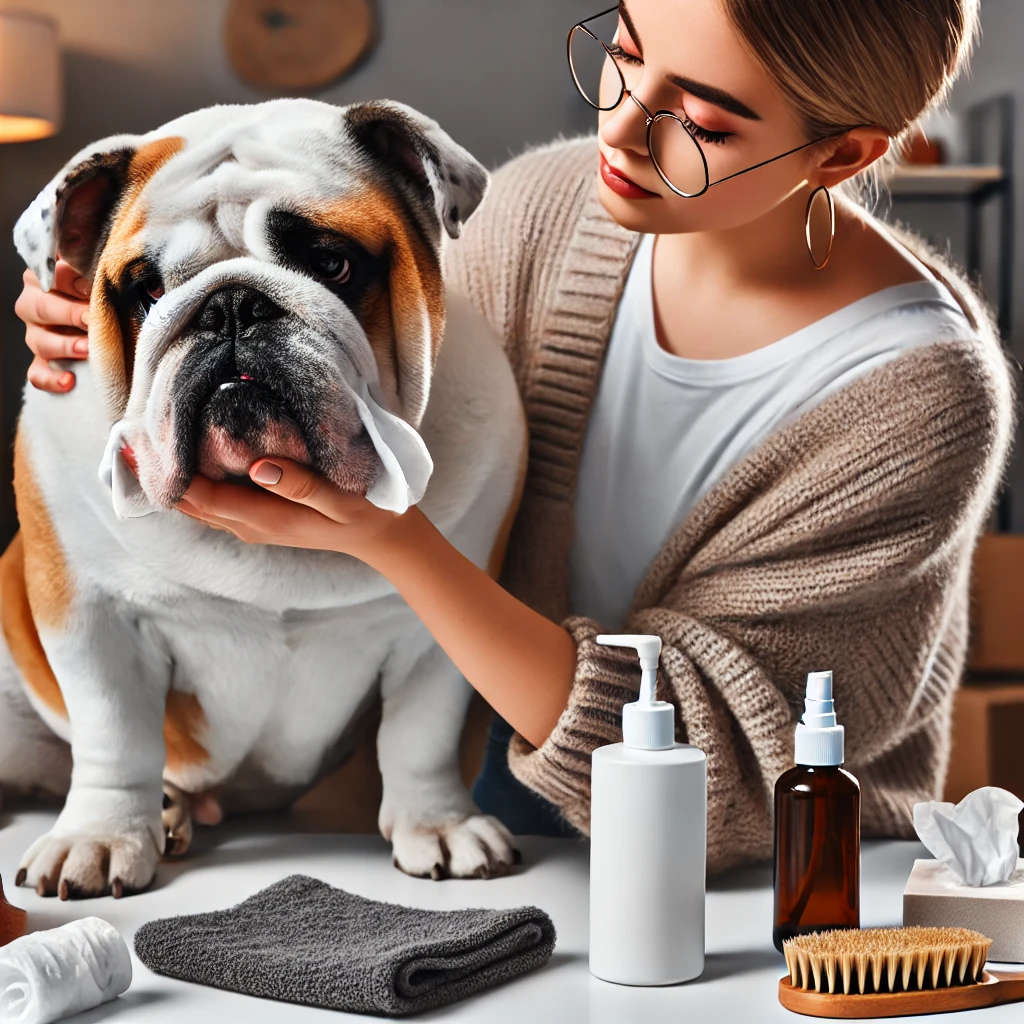Your cart is currently empty!
Understanding Bulldog Skin Fold Infections, a fur-parents guide.

Bulldogs are beloved for their adorable wrinkled faces and distinctive skin folds. Unfortunately, those same folds create a warm, moist environment that can become a breeding ground for bacteria, yeast, and other pathogens. Understanding the causes, diagnosis methods, and treatment strategies for Bulldog skin fold infections is essential for maintaining your furry friend’s health and comfort.
Causes of Skin Fold Infections in Bulldogs
Bulldogs are highly susceptible to skin fold infections due to their distinct facial wrinkles, tail pockets, and other body folds. The primary causes include:
1. Moisture Accumulation
- Sweat, tears, or saliva can collect in the folds, creating an ideal environment for bacteria and yeast to thrive.
2. Bacterial Infections
- Common bacterial pathogens such as Staphylococcus species are frequent culprits.
3. Yeast Infections
- Malassezia yeast naturally lives on canine skin but can overgrow in moist environments.
4. Food Allergies or Environmental Allergens
- Allergens may cause inflammation, intensifying irritation and infection in the folds.
5. Poor Hygiene
- Insufficient cleaning of the folds can lead to grime buildup, which exacerbates infection risks.
6. Obesity
- Excess fat deposits may deepen skin folds, increasing the risk of trapped debris.
Diagnosing the Cause of Bulldog Skin Fold Infections
Proper diagnosis is key to effective treatment. Here’s how to verify the cause:
At Home Observation
- Smell: A foul or musty odor is a telltale sign of infection.
- Discharge: Yellowish, brown, or greenish discharge may indicate bacterial infection.
- Redness and Swelling: Inflamed, irritated skin suggests infection or irritation.
- Scratching or Rubbing: Persistent scratching near the face, paws, or tail may point to discomfort.
Veterinary Diagnostics
- Cytology Test: A vet may take a sample from the infected area to identify bacteria or yeast.
- Skin Scraping: Used to rule out parasites.
- Allergy Testing: Recommended if allergies are suspected as a root cause.
At-Home Treatment Protocols
If the infection is mild and caught early, you can often treat it effectively at home.
1. Cleaning the Affected Area
- Use a soft cloth or cotton pad soaked in a veterinarian-recommended antiseptic solution.
- Mild Solutions for Cleaning:
- Diluted chlorhexidine (0.2-0.5%)
- Hypochlorous acid spray (safe and non-toxic)
- Diluted iodine solution (Betadine)
Steps for Cleaning:
- Gently wipe the infected fold to remove debris and discharge.
- Dry the area thoroughly using a clean towel or absorbent cotton pad.
- Repeat 1-2 times daily until the infection subsides.
2. Topical Treatments
- Antibacterial Ointments: Over-the-counter options such as Neosporin can be helpful.
- Anti-Yeast Creams: Look for creams containing clotrimazole or miconazole.
- Medicated Wipes: Wipes containing chlorhexidine, ketoconazole, or benzoyl peroxide can clean and disinfect folds effectively.
3. Home Remedies
While some natural remedies have shown positive effects, use these with caution:
- Coconut Oil – Known for its antibacterial and anti-inflammatory properties. Apply sparingly.
- Apple Cider Vinegar (Diluted 50/50 with water) – Acts as a natural antifungal and antibacterial agent. Avoid applying to open wounds.
- Aloe Vera Gel – Soothes irritation and reduces inflammation.
4. Dietary Support
- Omega-3 fatty acids (found in fish oil) can improve skin barrier function and reduce inflammation.
- Probiotics may help manage yeast overgrowth.
When to Involve Your Veterinarian
Consult your veterinarian if you notice the following signs:
- Infection worsens despite home treatment.
- Persistent foul odor or oozing discharge.
- Severe redness, swelling, or signs of pain.
- Recurrent infections that keep returning.
- Signs of systemic illness (lethargy, loss of appetite).
Your vet may prescribe:
- Oral Antibiotics: For moderate to severe bacterial infections.
- Antifungal Medications: For persistent yeast infections.
- Steroids or Anti-Inflammatories: To reduce severe inflammation.
Prevention Strategies
Preventing Bulldog skin fold infections requires a combination of consistent hygiene and lifestyle adjustments.
Daily Cleaning Routine
- Clean your Bulldog’s face, tail pocket, and other folds daily using gentle wipes or damp cloths.
- Ensure the area is completely dry to prevent moisture buildup.
Grooming Practices
- Trim excess fur in and around the folds to reduce heat and moisture retention.
- Bathe your Bulldog using a mild, medicated shampoo if they are prone to infections.
Healthy Diet
- Provide a balanced, high-quality diet to promote healthy skin.
- Consider hypoallergenic diets if your Bulldog has allergy-related issues.
Weight Management
- Maintain your Bulldog at a healthy weight to prevent deepened folds that worsen infection risks.
Recommended Medications
Over-the-Counter (OTC) Products
- Vetericyn Plus Antimicrobial Hydrogel – Ideal for cleaning and soothing infected folds.
- Curaseb Antifungal Spray – Combats yeast and bacterial infections.
- MalAcetic Wipes – Excellent for daily cleaning of facial folds.
Veterinarian-Prescribed Medications
- Apoquel (oclacitinib) – Manages inflammation and itching.
- Cefpodoxime (antibiotic) – Effective against bacterial infections.
- Ketoconazole – Strong antifungal medication.
Natural Remedies (Research-Backed)
Several natural treatments have demonstrated effectiveness for managing skin fold infections:
- Tea Tree Oil (Highly Diluted): Has antibacterial and antifungal properties. Avoid undiluted use.
- Witch Hazel: A natural astringent that reduces moisture buildup in folds.
- Calendula Oil: Known for its soothing and anti-inflammatory properties.
Important Note
While many skin fold infections can be managed at home, persistent or severe cases should always be evaluated by a veterinarian. Early intervention can prevent complications and ensure your Bulldog remains happy and healthy.
Your Bulldog Deserves the Best Care
By maintaining consistent hygiene, providing a balanced diet, and recognizing early signs of infection, you can effectively prevent and manage Bulldog skin fold issues. Combine preventive strategies with proactive treatment for optimal results.
If you’d like guidance on specific products, treatment steps, or Bulldog grooming tips, feel free to ask!
